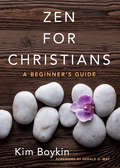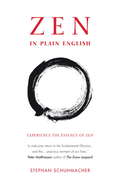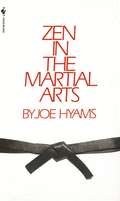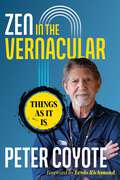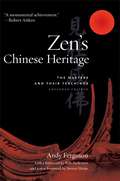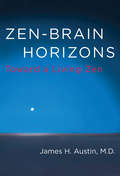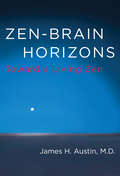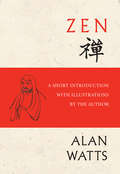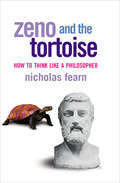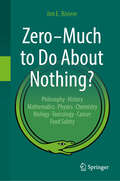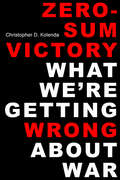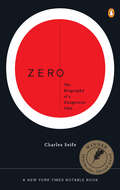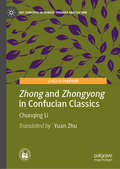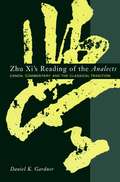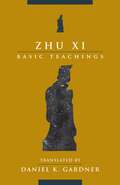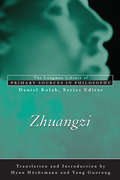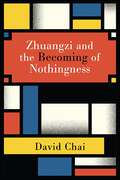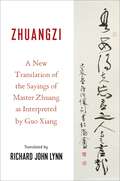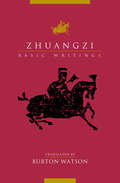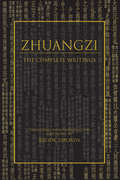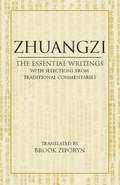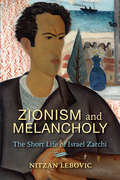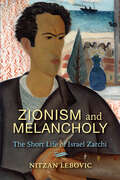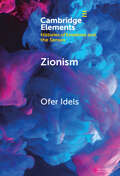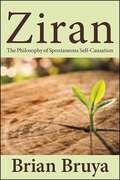- Table View
- List View
Zen for Christians: A Beginner's Guide
by Gerald G. May Kim Boykin"Whereas other Christianity-meets-Buddhism books stress ideology and the intellect, this one emphasizes daily acts of practice." — Publishers Weekly (starred review) In this illuminating and insightful guide, Kim Boykin offers Christians a way to incorporate Zen practices into their lives without compromising their beliefs and faith.Zen for Christians assumes curiosity but no real knowledge as it walks readers through specific concepts of Zen philosophy — including suffering, attachment, and enlightenment — and explains each in a simple but lively way. Sections between chapters gently demonstrate Zen meditation practices, explaining the basics in a clear, engaging manner. Placing Buddhist and Christian teachings side by side helps readers not only understand Zen but also shows their compatibility. Drawing on Dr. Boykin's own personal search through Buddhism and Christianity as well as her background in theological studies, this thought-provoking work illustrates how Zen practice can be particularly useful for Christians who want to enrich their faith by incorporating contemplative practices."An excellent introduction to Zen — clear and to the point, practical, respectful, and even humorous at times." — Yoga Journal "Makes Zen practice more approachable and less esoteric … a straightforward guide for those who want to try Zen for themselves." — Monastic Interreligious Dialogue Bulletin "A trustworthy and delightful guide. Kim Boykin will demystify and deepen your understanding of both the traditions she practices. A gem!" — James W. Fowler, author, Stages of Faith "Kim Boykin writes in the skilled language of simplicity. While addressing those new to Zen, she offers practical wisdom, challenge, and encouragement to all practitioners." — Rose Mary Dougherty, Shalem Institute for Spiritual Formation, Bethesda, Maryland "The great religions of the world have much to learn from each other. Kim Boykin's book is a skillful step in that direction. The heart of the matter of Zen is presented in a direct and informative way that is based on her firsthand experience of Zen training. This should prove to be a helpful guidebook for any Christian who wishes to explore Zen practice." — John Daido Loori, roshi, abbot, Zen Mountain Monastery "This lovely, wise, and practical introduction to Zen keeps its promise of companionship as the kind of spiritual cookbook you can bring right into the kitchen. Recipe-reading like this, in fact, inspires you to get into the kitchen, encourages you to keep at it, and invites you to share your efforts in communion with others." — Steven Tipton, coauthor, Habits of the Heart "An excellent resource on Zen practice, written from a pragmatic, personal, and yet sophisticated point of view. What a fine contribution to Buddhist-Christian understanding!" — Judith Simmer-Brown, coauthor, Benedict's Dharma: Buddhists Comment on the Rule "This is a good-humored, intelligent, nonguilt-inducing book written by a person who shows us clearly what it would be like to reap the benefits of what she preaches." — Roberta Bondi, author, Memories of God and Houses: A Family Memoir of Grace
Zen in Plain English
by Stephan SchuhmacherNo other book quite engages the reader in the kinds of perceptions and experiences that the seeker will have while following this path. The Zen masters are famous for their unorthodox ways of teaching the wisdom of the 'thing itself'. Their Koans - paradoxical stories, and questions - are designed to rid the mind of over-sophisticated responses. A selection of tales from the great Zen teachers, this book coaxes the reader into a direct encounter with the life-changing perceptions of the Zen mind. Challenging us to find 'a solution that resolves and dissolves the knots in heart and mind, the chronic cramp that prevents us from breathing freely, from giving ourselves without reserve to life in all its delightful and painful facets, and from being at peace with life and with death.' In this process we are confronted by the limits of rational meaning - and we begin to understand why Zen masters use humour and paradox to lead us to the very edge of the precipice of reason, and why, at that critical point, we are gently pushed over.'Stephan Schumacher's innovative format and his fresh interpretations of this fine selection of stories from the great teachers are a useful introduction to Zen practice, and more importantly a welcome return to the fundamental Dharma of no-self, not-knowing, the thing- itself and the beauty and precision of this moment-by-moment precious moment of our lives.' Peter Matthiessen(Muryo Roshi)
Zen in the Martial Arts
by Joe Hyams"A man who has attained mastery of an art reveals it in his every action. "--Samurai Maximum. Under the guidance of such celebrated masters as Ed Parker and the immortal Bruce Lee, Joe Hyams vividly recounts his more than 25 years of experience in the martial arts. In his illuminating story, Hyams reveals to you how the daily application of Zen principles not only developed his physical expertise but gave him the mental discipline to control his personal problems-self-image, work pressure, competition. Indeed, mastering the spiritual goals in martial arts can dramatically alter the quality of your life-enriching your relationships with people, as well as helping you make use of all your abilities.
Zen in the Vernacular: Things As It Is
by Peter Coyote• Shows how Zen offers a creative problem-solving mechanism and moral guide ideal for the stresses and problems of daily life• Shares the author&’s secular, vernacular interpretations of the Four Noble Truths, the Three Treasures, the Eightfold Path, and other fundamental Buddhist ideasDuring the nearly 3,000 years since the Buddha lived, his teachings have spread widely around the globe. In each culture where Buddhism was introduced, the Buddha&’s teachings have been pruned and modified to harmonize with local customs, laws, and cultures. We can refer to these modifications as &“gift wrapping,&” translating the gifts of Buddha&’s teachings in ways sensible to particular cultures in particular times. This gift-wrapping explains why Indian, Tibetan, Vietnamese, Japanese, Chinese, and Indonesian Buddhism have significant differences.In this engaging guide to Zen Buddhism, award-winning actor, narrator, and Zen Buddhist priest Peter Coyote helps us peer beneath the Japanese gift-wrapping of Zen teachings to reveal the fundamental teachings of the Buddha and show how they can be applied to contemporary daily life. The author explains that the majority of Western Buddhists are secular and many don&’t meditate, wear robes, shave their heads, or believe in reincarnation. He reminds us that the mental/physical states achieved by Buddhist practice are universal human states, ones we may already be familiar with but perhaps never considered as possessing spiritual dimensions.Exploring Buddha&’s core teachings, the author shares his own secular and accessible interpretations of the Four Noble Truths, the Three Treasures, and the Eightfold Path within the context of his lineage and the teachings of his teacher and the teachers before him. He looks at Buddha&’s teachings on our singular reality that appears as a multiplicity of things and on the &“self&” that perceives reality, translating powerful spiritual experience into the vernacular of modern life.Revealing the practical usefulness of Buddhist philosophy and practice, Zen in the Vernacular shows how Zen offers a creative problem-solving mechanism and moral guide ideal for the stresses and problems of everyday life.
Zen's Chinese Heritage
by Tenshin Reb Anderson Steven Heine Andy FergusonZen's Chinese Heritage traces twenty-five generations of inlightened Buddhist teachers, supplementing their core teachings with history, biography, and poetry. The result is an intimate and profound human portrait of the enlightened Zen ancients, and an unprecedented look into the depths of the rich cultural heritage. In this new edition with even more valuable material, Ferguson surveys generations of Zen masters, moving chronologically through successive generations of ancestral teachers, supplementing their core teachings with history, biography, and starkly beautiful poetry. In addition to giving the reader the engaging sense of the "family history" of Zen, this uniquely valuable book paints a clear picture of the tradition's evolution as a religious, literary, and historical force.
Zen-Brain Horizons: Toward a Living Zen (The MIT Press)
by James H. AustinIn Zen-Brain Horizons, James Austin draws on his decades of experience as a neurologist and Zen practitioner to clarify the benefits of meditative training. Austin integrates classical Buddhist literature with modern brain research, exploring the horizons of a living, neural Zen. When viewed in the light of today, the timeless wisdom of some Zen masters seems almost to have anticipated recent research in the neurosciences. The keen attentiveness and awareness that we cultivate during meditative practices becomes the leading edge of our subsequent mental processing. Austin explains how our covert, involuntary functions can make crucial contributions to the subtle ways we learn, intuit, and engage in creative activities. Austin begins by looking back at ancient Buddhist narratives. He then weaves together the major themes of self, attention, emotion, language, and insight. He goes on to examine Zen and psychology as cultural developments, including recent information about how a clear, calm awareness can change the meditating brain. He considers the pathways through which intuitions develop on their way to becoming realized, exploring the phenomena of the spontaneous color imagery that arises during meditation. Looking out even further into the future, Austin discusses the universal themes of creativity, happiness, openness, and selflessness. Along the way, he bows in homage to William James, explores "Buddhist Botany" and "Avian Zen," demonstrates why living Zen means much more than sitting quietly indoors on a cushion, and provides simplified advice that helps guide readers to the most important points.
Zen-Brain Horizons: Toward a Living Zen (The\mit Press Ser.)
by James H. AustinA neurologist and Zen practitioner clarifies the benefits of meditative training, drawing on classical Buddhist literature and modern brain research.In Zen-Brain Horizons, James Austin draws on his decades of experience as a neurologist and Zen practitioner to clarify the benefits of meditative training. Austin integrates classical Buddhist literature with modern brain research, exploring the horizons of a living, neural Zen. When viewed in the light of today, the timeless wisdom of some Zen masters seems almost to have anticipated recent research in the neurosciences. The keen attentiveness and awareness that we cultivate during meditative practices becomes the leading edge of our subsequent mental processing. Austin explains how our covert, involuntary functions can make crucial contributions to the subtle ways we learn, intuit, and engage in creative activities. He demonstrates why living Zen means much more than sitting quietly indoors on a cushion, and provides simplified advice that helps guide readers to the most important points.
Zen: A Short Introduction with Illustrations by the Author (Pelican Bks.)
by Alan WattsAccording to Alan Watts, &“Zen taste deplores the cluttering of a picture or of a room with many objects.&” In that sense, this minimalist book embodies the aesthetic of Zen itself. As with brushstrokes in a Japanese ink painting, the words have been used sparingly and arranged precisely, with no unnecessary detail. In seven brief chapters, Watts captures the essence of Zen Buddhism as a religion and a way of life. He explains fundamental Zen concepts, introduces revered Zen thinkers, places Zen within the broader context of Eastern religion, and traces the influence of Zen in the arts. Illustrated with calligraphy and drawings by the author, this reprint of an old classic will delight fans of Alan Watts, while introducing new readers to a legendary author who infused groundbreaking scholarship with literary brilliance.
Zeno and the Tortoise: How to Think Like a Philosopher
by Nicholas FearnFor those who don't know the difference between Lucretius's spear and Hume's fork, Zeno and the Tortoise explains not just who each philosopher was and what he thought, but exactly how he came to think in the way he did. Nicholas Fearn presents philosophy as a collection of tools — the tricks of a trade that, in the end, might just be all tricks, each to be fruitfully applied to a variety of everyday predicaments. In a witty and engaging style that incorporates everything from Sting to cell phones to Bill Gates, Fearn demystifies the ways of thought that have shaped and inspired humanity — among many others, the Socratic method, Descartes's use of doubt, Bentham's theory of utilitarianism, Rousseau's social contract, and, of course, the concept of common sense. Along the way, there are fascinating biographical snippets about the philosophers themselves: the story of Thales falling down a well while studying the stars, and of Socrates being told by a face-reader that his was the face of a monster who was capable of any crime. Written in twenty-five short chapters, each readable during the journey to work, Zeno and the Tortoise is the ideal course in intellectual self-defense. Acute, often irreverent, but always authoritative, this is a unique introduction to the ideas that have shaped us all. "Entertaining and witty. A smooth, sweet concoction that should tickle the taste buds of the most philosophobic readers." — Julian Boggini, The Times Educational Supplement (U.K.) "A concise and entertaining attempt to place the skills of philosophy at our fingertips." — Olivier Burckhardt, The Independent on Sunday (U.K.)
Zero – Much to Do About Nothing?
by Jim E. RiviereZero – Much to Do About Nothing? is a thought-provoking work that delves into the complexities of defining “zero” in various fields, from mathematics and physics to pharmacology and food safety. Drawing on his extensive experience in teaching, research and managing a USDA-supported chemical food safety program, Jim E. Riviere provides readers with practical examples and case studies that highlight the challenges of defining “zero” in different contexts across a wide range of fields. In his four decades of university teaching, doing research in pharmacology, toxicology, biomathematics and nanoscience, Dr. Riviere has repeatedly encountered the concept of “zero” and the broad parameters utilized to achieve a proper definition. "Zero” enters when discussions concern defining "nothing", "negligible", "very small", "below level of detection", "absence of effect" or "safe". This renders the term “zero” incredibly confusing to scientists, practitioners and regulators. This book explores the origin of the concept of “zero” in mathematics, physics, chemistry and statistics and how these concepts migrated to fields such as pharmacology, toxicology, cancer research and food safety, as well as to the legal profession in the form of regulatory science and policy. Specific chapters deal with the application of “zero” to these distinct fields. The main focus throughout the book is to illustrate how important context is to the definition of “zero”. This has assumed greater relevance today with the advent of nanoscience where “small” implies different physical and chemical behavior and the use of artificial Intelligence to analyze vast troves of data from the web. The goal of the book is to provide much-needed clarity about "zero" and break down the many issues preventing it. Riviere expertly explains how the concept of “zero” is essential to a wide range of issues, from defining negligible amounts of a substance to determining the safety of a product or process. He shows how the term “zero” can have different meanings in different fields and how this can lead to confusion and misunderstandings among scientists, practitioners and regulators. Whether you're working in Food Safety, Chemistry, Pharmacology, Mathematics, Physics or beyond, Zero – Much to Do About Nothing? is a relatable book that will deepen your understanding of the concept of “zero” and its diverse applications.
Zero-Sum Victory: What We're Getting Wrong About War
by Christopher D. KolendaThe military expert and author of Leadership presents &“the most thoughtful analysis yet of America&’s recent conflicts—and future challenges&” (Gen. Stanley A. McChrystal). Why have the major post-9/11 US military interventions turned into quagmires? Despite huge power imbalances in America&’s favor, capacity-building efforts, and tactical victories, the wars in Afghanistan and Iraq turned intractable. The US government&’s fixation on zero-sum, decisive victory in these conflicts is a key reason why these operations failed to achieve favorable and durable outcomes. In Zero-Sum Victory, retired US Army colonel Christopher D. Kolenda identifies three interrelated problems that have emerged from the government&’s insistence on zero-sum victory. First, the US government has no way to measure successful outcomes other than a decisive military victory, and thus, selects strategies that overestimate the possibility of such an outcome. Second, the United States is slow to recognize, modify, or abandon losing strategies. Third, once the United States decides to withdraw, bargaining asymmetries and disconnects in strategy undermine the prospects for a successful transition or negotiated outcome. Relying on historic examples and personal experience, Kolenda draws thought-provoking and actionable conclusions about the utility of American military power in the contemporary world—insights that serve as a starting point for future scholarship as well as for important national security reforms.
Zero: The Biography of a Dangerous Idea
by Charles SeifeThe Babylonians invented it, the Greeks banned it, the Hindus worshiped it, and the Church used it to fend off heretics. Now it threatens the foundations of modern physics. For centuries the power of zero savored of the demonic; once harnessed, it became the most important tool in mathematics. For zero, infinity's twin, is not like other numbers. It is both nothing and everything. In Zero, Science Journalist Charles Seife follows this innocent-looking number from its birth as an Eastern philosophical concept to its struggle for acceptance in Europe, its rise and transcendence in the West, and its ever-present threat to modern physics. Here are the legendary thinkers—from Pythagoras to Newton to Heisenberg, from the Kabalists to today's astrophysicists—who have tried to understand it and whose clashes shook the foundations of philosophy, science, mathematics, and religion. Zero has pitted East against West and faith against reason, and its intransigence persists in the dark core of a black hole and the brilliant flash of the Big Bang. Today, zero lies at the heart of one of the biggest scientific controversies of all time: the quest for a theory of everything. .
Zhong and Zhongyong in Confucian Classics (Key Concepts in Chinese Thought and Culture)
by Chunqing LiThis Key Concept pivot explores the trajectory of the semantic generation and evolution of two core concepts of ancient Chinese Confucianism, ‘Zhong’ (middle) and ‘Zhongyong’ (golden mean). In the pre-Qin period, Confucius advocated ‘middle line’ and ‘golden mean’ as the highest standards for gentlemanly behaviour and culture. In The Doctrine of the Mean the Confucian classic of the late Warring States Period, ‘middle’ obtained the ontological meaning of ‘great fundamental virtues of the world’, due to the influence of Taoism and Yinyang School. It became not only the norm of human behaviours, but also the law governing the operation of heaven and earth. Since then, idealist Confucian scholars of the Song and Ming dynasties have developed the meaning of ‘middle’ from the perspective of the relationships between heaven and man, a fundamental norm of Confucian ethics.
Zhu Xi's Reading of the Analects: Canon, Commentary, and the Classical Tradition
by Daniel GardnerThe Analects is a compendium of the sayings of Confucius (551–479 b.c.e.), transcribed and passed down by his disciples. How it came to be transformed by Zhu Xi (1130–1200) into one of the most philosophically significant texts in the Confucian tradition is the subject of this book.Scholarly attention in China had long been devoted to the Analects. By the time of Zhu Xi, a rich history of commentary had grown up around it. But Zhu, claiming that the Analects was one of the authoritative texts in the canon and should be read before all others, gave it a still more privileged status in the tradition. He spent decades preparing an extended interlinear commentary on it. Sustained by a newer, more elaborate language of metaphysics, Zhu's commentary on the Analects marked a significant shift in the philosophical orientation of Confucianism—a shift that redefined the Confucian tradition for the next eight centuries, not only in China, but in Japan and Korea well.Gardner's translations and analysis of Zhu Xi's commentary on the Analects show one of China's great thinkers in an interesting and complex act of philosophical negotiation. Through an interlinear, line-by-line "dialogue" with Confucius, Zhu effected a reconciliation of the teachings of the Master, commentary by later exegetes, and contemporary philosophical concerns of Song-dynasty scholars. By comparing Zhu's reading of the Analects with the earlier standard reading by He Yan (190–249), Gardner illuminates what is dramatically new in Zhu Xi's interpretation of the Analects.A pioneering study of Zhu Xi's reading of the Analects, this book demonstrates how commentary is both informed by a text and informs future readings, and highlights the importance of interlinear commentary as a genre in Chinese philosophy.
Zhu Xi: Basic Teachings
by Xi ZhuZhu Xi (1130–1200) was the preeminent Confucian thinker of the Song dynasty (960–1279). His teachings profoundly influenced China, where for centuries after his death they formed the basis of the country’s educational system. In Korea, Japan, and Vietnam as well, elites embraced his inspired and authoritative synthesis of Confucian thought.In Zhu’s eyes, the great Way of China was in decline, with its very survival threatened by external enemies and internal moral weakness. In his writings and teaching, Zhu took as his mission the revival of the Confucian tradition, the source of China’s greatness, and its transmission to future generations. For him, restoring Confucianism to its rightful place required drawing on the tradition’s whole sweep, from the sacred texts of the sages and worthies of antiquity to the more recent writings of the great thinkers of the tenth and eleventh centuries.This book presents the essential teachings of the new Confucian (“Neo-Confucian”) philosophical system that Zhu Xi forged, providing a concise introduction to one of the most important figures in the history of Chinese thought. It offers selections from the Classified Conversations of Master Zhu (Zhuzi yulei), a lengthy collection of Zhu’s conversations with disciples. In these texts, Zhu Xi reflects on the Confucian teachings of the past, revising and refining his understanding of them and shaping that understanding into a cohesive system of thought. Daniel K. Gardner’s translation renders these discussions and sayings in a conversational style that is accessible to new and more advanced readers alike.
Zhuangzi (Longman Library of Primary Sources in Philosophy)
by Chuang TzuPart of the “Longman Library of Primary Sources in Philosophy,” this translation/edition of Chuang Tzu's works is framed by a pedagogical structure designed to make this important work of philosophy more accessible and productive for undergraduates.
Zhuangzi and the Becoming of Nothingness (SUNY series in Chinese Philosophy and Culture)
by David ChaiZhuangzi and the Becoming of Nothingness offers a radical rereading of the Daoist classic Zhuangzi by bringing to light the role of nothingness in grounding the cosmological and metaphysical aspects of its thought. Through a careful analysis of the text and its appended commentaries, David Chai reveals not only how nothingness physically enriches the myriad things of the world, but also why the Zhuangzi prefers nothingness over being as a means to expound the authentic way of Dao. Chai weaves together Dao, nothingness, and being in order to reassess the nature and significance of Daoist philosophy, both within its own historical milieu and for modern readers interested in applying the principles of Daoism to their own lived experiences. Chai concludes that nothingness is neither a nihilistic force nor an existential threat; instead, it is a vital component of Dao's creative power and the life-praxis of the sage.
Zhuangzi: A New Translation of the Sayings of Master Zhuang as Interpreted by Guo Xiang (Translations from the Asian Classics)
by Richard John LynnThe Zhuangzi (Sayings of Master Zhuang) is one of the foundational texts of the Chinese philosophical tradition and the cornerstone of Daoist thought. The earliest and most influential commentary on the Zhuangzi is that of Guo Xiang (265–312), who also edited the text into the thirty-three-chapter version known ever since. Guo’s commentary enriches readings of the Zhuangzi, offering keen insights into the meaning and significance of its pithy but often ambiguous aphorisms, narratives, and parables.Richard John Lynn’s new translation of the Zhuangzi is the first to follow Guo’s commentary in its interpretive choices. Unlike any previous translation into any language, its guiding principle is how Guo read the text; Lynn renders the Zhuangzi in terms of Guo’s understanding. This approach allows for the full integration of the text of the Zhuangzi with Guo’s commentary. The book also features a translation of Guo’s complete interlinear commentary and is annotated throughout.A critical introduction includes a detailed account of Guo’s life and times as well as analysis of his essential contributions to the arcane learning (xuanxue) of the fourth century and the development of Chinese philosophy. Lynn sheds new light on how the Daoist classic, which has often been seen as a timeless book of wisdom, is situated in its historical context, while also considering it as a guide to personal cultivation and self-realization.
Zhuangzi: Basic Writings (Translations from the Asian Classics)
by ZhuangziOnly by inhabiting Dao (the Way of Nature) and dwelling in its unity can humankind achieve true happiness and freedom, in both life and death. This is Daoist philosophy's central tenet, espoused by the person—or group of people—known as Zhuangzi (369?–286? BCE) in a text by the same name. To be free, individuals must discard rigid distinctions between right and wrong, and follow a course of action not motivated by gain or striving. When one ceases to judge events as good or bad, man-made suffering disappears, and natural suffering is embraced as part of life.Zhuangzi elucidates this mystical philosophy through humor, parable, and anecdote, using non sequitur and even nonsense to illuminate truths beyond the boundaries of ordinary logic. Boldly imaginative and inventively written, the Zhuangzi floats free of its historical period and society, addressing the spiritual nourishment of all people across time. One of the most justly celebrated texts of the Chinese tradition, the Zhuangzi is read by thousands of English-language scholars each year, yet, until now, only in the Wade-Giles romanization. Burton Watson's conversion to pinyin in this book brings the text in line with how Chinese scholars, and an increasing number of other scholars, read it.
Zhuangzi: The Complete Writings
by ZhuangziBrook Ziporyn's carefully crafted, richly annotated translation of the complete writings of Zhuangzi—including a lucid Introduction, a Glossary of Essential Terms, and a Bibliography—provides readers with an engaging and provocative deep dive into this magical work.
Zhuangzi: With Selections from Traditional Commentaries
by Brook Ziporyn ZhuangziIdeal for students and scholars alike, this edition of Zhuangzi (Chuang Tzu) includes the complete Inner Chapters, extensive selections from the Outer and Miscellaneous Chapters, and judicious selections from two thousand years of traditional Chinese commentaries, which provide the reader access to the text as well as to its reception and interpretation. A glossary, brief biographies of the commentators, a bibliography, and an index are also included.
Zionism and Melancholy: The Short Life of Israel Zarchi (New Jewish Philosophy and Thought)
by Nitzan LebovicNitzan Lebovic claims that political melancholy is the defining trait of a generation of Israelis born between the 1960s and 1990s. This cohort came of age during wars, occupation and intifada, cultural conflict, and the failure of the Oslo Accords. The atmosphere of militarism and conservative state politics left little room for democratic opposition or dissent. Lebovic and others depict the failure to respond not only as a result of institutional pressure but as the effect of a long-lasting "left-wing melancholy." In order to understand its grip on Israeli society, Lebovic turns to the novels and short stories of Israel Zarchi. For him, Zarchi aptly describes the gap between the utopian hope present in Zionism since its early days and the melancholic reality of the present. Through personal engagement with Zarchi, Lebovic develops a philosophy of melancholy and shows how it pervades Israeli society.
Zionism and Melancholy: The Short Life of Israel Zarchi (New Jewish Philosophy and Thought)
by Nitzan Lebovic“Lebovic reveals a great deal about the work of Zarchi and the melancholic mindset of an entire generation of contemporary Israelis . . . Highly recommended.” —ChoiceNitzan Lebovic claims that political melancholy is the defining trait of a generation of Israelis born between the 1960s and 1990s. This cohort came of age during wars, occupation and intifada, cultural conflict, and the failure of the Oslo Accords. The atmosphere of militarism and conservative state politics left little room for democratic opposition or dissent.Lebovic and others depict the failure to respond not only as a result of institutional pressure but as the effect of a long-lasting “left-wing melancholy.” In order to understand its grip on Israeli society, Lebovic turns to the novels and short stories of Israel Zarchi. For him, Zarchi aptly describes the gap between the utopian hope present in Zionism since its early days and the melancholic reality of the present. Through personal engagement with Zarchi, Lebovic develops a philosophy of melancholy and shows how it pervades Israeli society.
Zionism: Emotions, Language and Experience (Elements in Histories of Emotions and the Senses)
by Ofer IdelsIs the history of emotions a methodology or a subject? What is the relationship between emotions and culture? What role does the body play in the human experience? Addressing these questions and more, this element emphasizes the often-overlooked role of emotional and sensory experiences when examining the Zionist experience in the early twentieth century. Focusing on the visceral and embodied historical aspects of the linguistic modernization of Hebrew, it argues that recent cultural studies on Jewish daily life in Palestine have reached an impasse, which the history of emotions could help us overcome. Interpreting Zionist texts not solely as symbolic myths but as a historical, lived experience, this element advocates for the significance of the history of emotions and experience as an innovative methodology with profound ethical implications for our polarized era.
Ziran: The Philosophy of Spontaneous Self-Causation (SUNY series in Chinese Philosophy and Culture)
by Brian BruyaZiran, an idea from ancient Daoism, defies easy translation into English but can almost be captured by the term "spontaneity." It means "self-causation," if "self" is understood as fundamentally plural, and "causation" is understood as sensitivity and responsiveness. Applying ziran to the fields of action theory, attention theory, and aesthetics, Brian Bruya uses easy-to-read, straightforward prose to show, step-by-step, how this philosophical concept from an ancient tradition can be used to advance theory today. Incorporated into contemporary philosophy of action, ziran opens us to the notion of movement and action as self-organizing. Incorporated into contemporary cognitive science, ziran opens us to the possibility of effortless attention, contrary to the reigning paradigm. Incorporated into contemporary aesthetics, ziran opens us to a new category of art—somatic art—and a new, refined understanding of improvisation.
